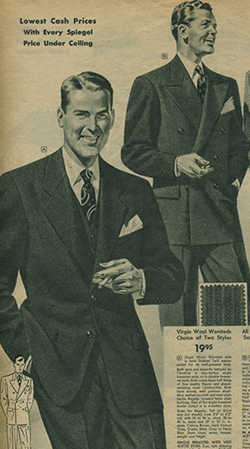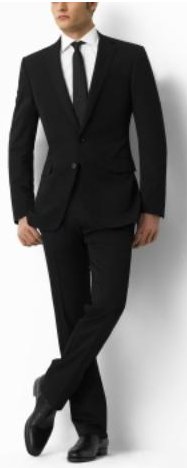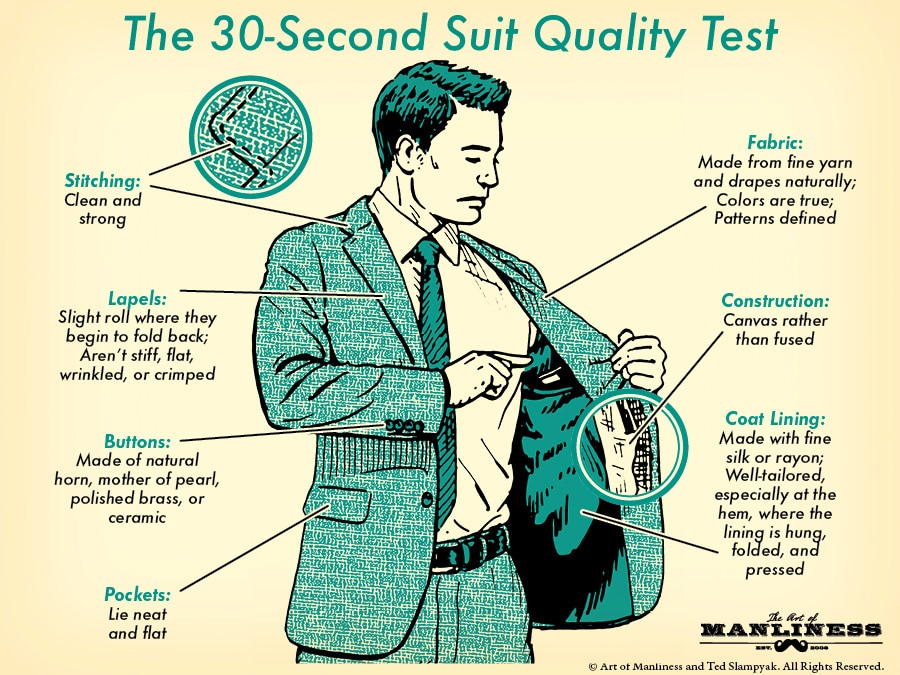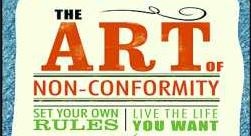
Editor’s note: The AoM Community’s resident style hobbyist, Leo Mulvihill, posted a series of posts on the Community blog to help men understand more about buying, wearing, and looking your best in a suit. We’ll be publishing his entries here every other week. Thanks for sharing your sartorial knowledge, Leo!
Fit is the single most important part of looking good in your suit. Without fit, even the richest man in the finest vicuña-cashmere blend suit comes across more as a rube than a rake. And short of having a suit-custom made specifically for your measurements, you will always have fit issues with any off the rack suit purchase. Making that off the rack suit fit you perfectly requires a few alterations.
Shoulders
When you first try on a suit jacket off the rack, you’re mainly checking for a fit in the shoulders. Virtually any other jacket alteration is possible and not terribly expensive. However, to get shoulders taken in can cost upwards of $100.00, and is rarely worth it.
Try on that jacket. The shoulder of the jacket should end where your shoulders naturally end; linebacker shoulders are a throwback to the 80s and early 90s and generally look atrocious, unless, of course, you’re this guy:

Generally, it’s not helpful to remind your interviewer of Patrick Bateman. Side note: Don’t comment on their business cards.
A properly fitting shoulder is one of the most important parts of fitting a suit. If the suit looks strange on you, or it feels either tight or too roomy, then don’t buy it.
Once you have a jacket that fits you in the shoulders, you’re ready to go to the tailor. Unless you’re in a higher-end clothing store, eschew in-house department store tailors or your local dry cleaner. Rather, find a local tailor with favorable reviews and whose work you can see.
The Three Alterations Every Suit Needs
Virtually every suit will need three basic alterations.
1. Sleeves Shortened
2. Pants Tailored
3. Waist Suppressed
Let’s take a look at each of these in depth.
1. Sleeves Shortened
Many off the rack suits have sleeves that are many inches too long. Ideally, you should allow 1/4″ to 1/2″ of shirt cuff (known as “linen”) to show when you rest your hands at your side. In most people, this equates to having the suit jacket end at the bump on the pinky side on your wrist, where your arm meets your hand. It will look something like this:

This look is classic and rakish. Look to the icons of men’s style – the Duke of Windsor, Cary Grant, Fred Astaire – and you’ll notice that each of these men follows this rule.
Walking around, you’ll notice scores of men who leave their sleeve unaltered and too long. As a result, they look like boys playing dress-up in their father’s suits. With properly tailored sleeves, you’ll avoid this juvenile look and instead appear mature and professional, making yourself stand out from your peers who’ve neglected this important detail. It’s small, but it makes a huge difference.
2. Pants Hemmed
Normally, pants on off the rack suits are unfinished and run about 38” long – too long for anyone to wear. You must have these hemmed. You have a few options.
To Cuff or Not to Cuff?
The first decision to make is cuffed v. non-cuffed pants. This is a matter of personal preference.
Cuffed pants are a more traditional option. Cuffs add weight to the bottom of the pant and allow the fabric to drape naturally because of the added weight of the cuff. Done right, it looks clean and classic.
If your suit trousers are pleated, cuffs are your best option. However, make sure that you’re wearing the trousers at the proper height. Pleated pants are not meant not be worn at the same height as jeans. Hike the waistband up to around your natural waist (around your navel) to avoid looking like you have about 30 extra pounds in your hips and thighs.
Non-cuffed pants are generally better suited for slim, plain front pants. Slim legs hug your body better and don’t require the extra weight at the bottom to make them drape properly. That said, cuffs do look excellent on straight leg pants. It’s a matter of your preference. If you want to really stand out, try getting two-inch cuffs.
The next decision you need to make is the break of the pant.
Break It Down
The break is the degree to which a pant extends down your leg, ranging from a full-break to no-break.
Full Break
A trouser with a full-break extends to about the top of the heel on your shoe and generally covers about 2/3 to 3/4 of the laces on your shoe. The pants neatly fold once where they meet the top of the shoe. Your socks generally do not show, even while walking. A full-break is best for wider-legged, pleated pants. It’s a traditional, classic look, popular with many older men and those who strictly adhere to the rules of dress.
No Break
A trouser with no break is known colloquially as a “flood.” The pant neatly ends at the top of the shoe. This is a look that is best suited for a slim, flat front trouser.
When you walk or sit, your socks are pretty much out there for everyone to see; this can be a good look for you if you like to showcase your wacky sock collection. While not terribly popular with any but the 60’s Ivy crowd, or Thom Browne, it can look rakish when pulled off well. A no-break trouser looks best with a cuff to weigh down the bottom of the pant.
If you decide to go this route, you have to know that it’s not without risks. Because you’re essentially breaking a rule of classic men’s style, you are going to have to do it with confidence; otherwise, you run the risk of looking like you’ve outgrown your trousers.
Half-Break
A compromise between the two extremes is the half-break. A half-break trouser is slightly shorter than a full-break, but longer than a flood. Instead of the pant hem ending at the top of the heel, it ends about 1/2 to 2/3 of the way down the shoe, allowing a slight fold where the cuff hits the shoe. Your socks may show while you walk. Half-break trousers are a nice look that’s equally suited for trousers of all finishes– flat front or pleated, plainly finished or cuffed.
Don’t forget to make sure the pants are properly sized around your waist while you’re at it.
So your sleeves are properly shortened and your pants are finished. Now it’s time to focus on your jacket’s fit.
3. Waist Suppression
Waist suppression is the descriptive term for the cinching of a jacket’s waist to accentuate the ideal “V” shape of the male torso. Many off the rack suits are rather boxy, so your tailor can rectify this by suppressing the waist of your jacket. When your tailor suppresses the waist, he helps the jacket hide whatever flaws you might have in order to make you appear that much closer to the masculine ideal.
This Ralph Lauren Black Label suit has rather aggressive waist suppression, but works well for illustrative purposes:

Compare that jacket to this, which has very little to no waist suppression:

With proper waist suppression, you’ll look less like a burlap sack and more like a human with shoulders and a waist. But remember – the jacket should be fitted, not tight. If you notice any pulling around the button in an “X” shape, it’s too tight.
I challenge you all to take out your suits, try them on, and see what alterations you need to get done. Take a trip to your tailor and see what he can do for you!
That’s it for today’s lesson, gentlemen. If you have any questions or suggestions for future articles, please contact me.
For further reading on waist suppression and alterations, as well as some excellent examples of tailoring done right, look at Ask Andy About Clothes and StyleForum.
And stay tuned for the next installment of the Art of Manliness Suit School.
_______________
Art of Manliness Suit School: Part 1 – Fused vs. Canvassed Suits
Art of Manliness Suit School: Part 3 – A Primer on Suit Buttons






